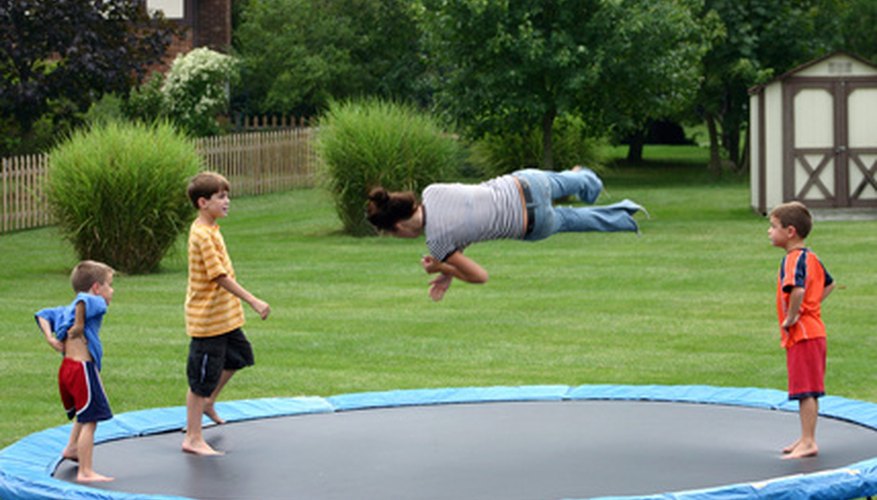A trampoline that tilts can throw the jumper off the side. The safest surface on which to erect a trampoline is a perfectly flat, level lawn; unfortunately, not very many lawns meet that criterion. But if your lawn slopes less than 2.5 cm (1 inch) for every 17.5 cm (7 inches) horizontal distance, you can correct for this by digging trenches into the up-slope legs. This can take some checking and rechecking, but it's worth it to have the safest possible trampoline set-up.
Set the trampoline in the area in which you will use it. Set a plank across the middle of the trampoline, so that in runs straight up and down in the direction of the slope.
Stand on the downslope side of the trampoline, and place the carpenter's level on the plank. Raise the end of the plank until the carpenter's level shows that the plank is level (the bubble is in the centre of the two lines). Use the ruler to measure the distance between the top of the trampoline and the upper edge of the board. This is the total amount of slope you need to correct.
- A trampoline that tilts can throw the jumper off the side.
- Use the ruler to measure the distance between the top of the trampoline and the upper edge of the board.
Divide the diameter of the trampoline by the total amount of slope. If the result is greater than 17.5 cm (7 inches), the area has too much slope to be corrected for the trampoline; you should move the trampoline to a different location.
Move the trampoline out of the way and dig a trench under the area where the uphill legs of the trampoline will be placed. The depth of this trench should equal the total amount of slope you measured. Use the carpenter's level to make sure the trench is level.
- Divide the diameter of the trampoline by the total amount of slope.
- Move the trampoline out of the way and dig a trench under the area where the uphill legs of the trampoline will be placed.
Move the trampoline back to its original position, with the uphill legs in the trench. The trampoline will be somewhat unstable because the side legs will now be higher than the uphill and downhill legs. Dig trenches under the side legs until both the uphill and downhill legs are seated firmly.
Check that the trampoline is now level in all directions, and adjust the trenches if necessary.
TIP
If your trampoline is placed on soft or sandy soil, you may need to place about 2.5 cm (1 inch) of gravel in the trenches to keep the trampoline from settling during use. Some people opt to dig a round, level hole about 7.5 cm (3 inches) deep to accommodate the entire trampoline base. This makes it easier to mount the trampoline and somewhat reduces the danger of a fall, but it involves a lot more digging. Work slowly and check level frequently as you dig your trenches. It's easier to deepen a trench than to firmly refill one that's too deep.
WARNING
A sloping or unstable trampoline greatly increases the risk of injury. Always follow manufacturer's assembly and use instructions carefully, and install all provided safety features. Trampolines can settle with the weight of continued use. Regularly check that the trampoline is still level, and correct any slope that occurs. Some types of trampoline legs cannot be safely levelled by trenching. Consult manufacturer's instructions.
